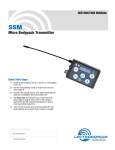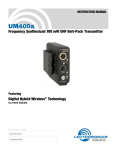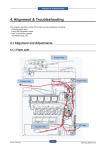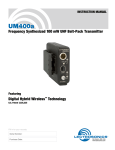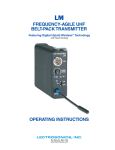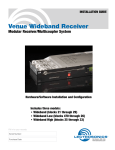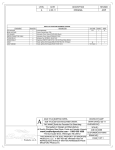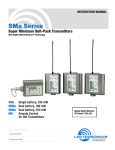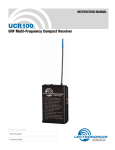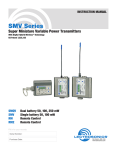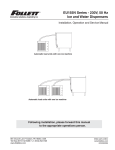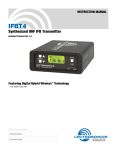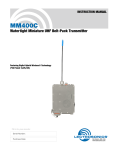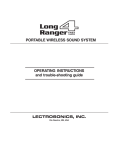Download Lectrosonics UT400 Wireless Handheld Transmitter user manual
Transcript
INSTRUCTION MANUAL UT Frequency Agile Hand-Held Transmitter Featuring Digital Hybrid Wireless™ Technology Fill in for your records: Serial Number: Purchase Date: Rio Rancho, NM, USA www.lectrosonics.com UT 2 LECTROSONICS, INC. Frequency-Agile Hand-Held Trasmitter Table of Contents General Technical Description .............................................................................................................................................................. 4 Introduction ........................................................................................................................................................................................... 4 Digital Hybrid Technology ..................................................................................................................................................................... 4 Digital Signal Processor ....................................................................................................................................................................... 4 Microprocessor, PLL and VCO Circuits ................................................................................................................................................ 4 Compatibility Modes ............................................................................................................................................................................. 5 Pilot Tone Squelch ................................................................................................................................................................................ 5 Wide-Band Deviation ............................................................................................................................................................................ 5 Input Limiter .......................................................................................................................................................................................... 5 Long Battery Life .................................................................................................................................................................................. 5 Frequency Agility .................................................................................................................................................................................. 5 Circulator/Isolator ................................................................................................................................................................................. 5 Antenna ................................................................................................................................................................................................ 5 Microphone Element ............................................................................................................................................................................ 5 Controls and Functions ......................................................................................................................................................................... 6 Power On/Off Switch ............................................................................................................................................................................ 6 Power LED ............................................................................................................................................................................................ 6 Compatibility Modes ............................................................................................................................................................................. 6 Frequency Switches ............................................................................................................................................................................. 7 Audio Level LEDs ................................................................................................................................................................................. 7 Audio Level Control .............................................................................................................................................................................. 7 Locked Mode ........................................................................................................................................................................................ 7 VariMic™ Controls ................................................................................................................................................................................. 8 Bass/Mid/Treble (LO/MID/HI) ................................................................................................................................................................ 8 Control Settings: ............................................................................................................................................................................... 8 Preamp Level Control ........................................................................................................................................................................... 8 Subsonic Noise Filter ........................................................................................................................................................................... 9 Interchangeable Capsules .................................................................................................................................................................... 9 VMO omnidirectional condenser ....................................................................................................................................................... 9 VMC cardioid condenser .................................................................................................................................................................. 9 VMS super-cardioid condenser ........................................................................................................................................................ 9 Changing Capsules ............................................................................................................................................................................. 10 Operating Instructions ........................................................................................................................................................................ 12 Selecting Compatibility Mode ............................................................................................................................................................. 12 Adjusting the Audio Gain .................................................................................................................................................................... 12 Power ON/OFF Switch Function Selection ......................................................................................................................................... 13 Determine Power Switch Function .................................................................................................................................................. 13 Changing Power Switch Function ................................................................................................................................................... 13 Battery Installation ............................................................................................................................................................................... 14 Operating Notes ................................................................................................................................................................................... 15 Adjusting the Transmitter Frequency .................................................................................................................................................. 15 Troubleshooting ................................................................................................................................................................................... 16 Specifications ....................................................................................................................................................................................... 17 Service and Repair ............................................................................................................................................................................... 18 Returning Units for Repair .................................................................................................................................................................. 18 Rio Rancho, NM 3 UT General Technical Description Introduction The UT Digital Hybrid Wireless™ handheld transmitter uses state-of-the-art wireless technology with a highpowered 100mW RF output and a unique microphone capsule arrangement. The VariMic™ preamp allows the user to custom-tailor the microphone’s response to suit the application. Three capsules are available for this transmitter: a cardioid condenser, an omni condenser and a supercardioid condenser. Each capsule assembly comes complete with the VariMic™ preamp. In addition to providing peerless audio quality in native 400 Series mode, the Digital Hybrid Wireless™ technology in the UT transmitter allows compatibility with a wide range of receiver types, including Lectrosonics 100 and 200 series and IFB. The UT is also compatible with receivers from other manufacturers. Contact Lectrosonics for details. Digital Hybrid Technology All wireless links suffer from channel noise to some degree and all wireless microphone systems seek to minimize the impact of that noise on the desired signal. Conventional analog systems use compandors for enhanced dynamic range, at the cost of subtle artifacts (known as “pumping” and “breathing”). Wholly digital systems defeat the noise by sending the audio information in digital form, at the cost of some combination of power, bandwidth and resistance to interference. The Lectrosonics Digital Hybrid Wireless™ system (hereafter called Digital Hybrid) overcomes channel noise in a dramatically new way, digitally encoding the audio in the transmitter and decoding it in the receiver, yet still sending the encoded information via an analog FM wireless link. This proprietary algorithm is not a digital implementation of an analog compandor but a technique which can be accomplished only in the digital domain, even though the inputs and outputs are analog signals. Because it uses an analog FM link, the Digital Hybrid enjoys all the benefits of conventional FM wireless systems, such as excellent range, efficient use of RF spectrum, and long battery life. However, unlike conventional FM systems, the Digital Hybrid has done away with the analog compandor and its artifacts. Digital Signal Processor The DSP encodes the digitized audio from the A-D converter and adds an ultrasonic pilot tone to control the receiver's squelch (only in 400 Series, 200 Series and IFB compatibility modes with the pilot tone enabled – see Pilot Tone Squelch). It also controls the input limiter and audio metering. Microprocessor, PLL and VCO Circuits An 8-bit microprocessor monitors numerous internal signals. It also drives the Modulation LEDs, controls the pilot tone and operates the PLL/VCO circuits. UT Block Diagram 4 LECTROSONICS, INC. Frequency-Agile Hand-Held Trasmitter Compatibility Modes The transmitter was designed to operate with Lectrosonics Digital Hybrid Wireless™ receivers and will yield the best performance when doing so. However, due to the flexibility of digital signal processing, it is also able to operate with Lectrosonics 200 Series, Lectrosonics 100 Series, IFB and certain nonLectrosonics analog receivers in special compatibility modes. (Contact the Lectrosonics Sales Department for a complete list of compatible receivers.) Pilot Tone Squelch The benefit of the pilot tone squelch system is that the associated receiver will remain muted until it receives the pilot tone from the matching transmitter, even if a strong RF signal is present on the carrier frequency of the system. All 400 Series transmitters use one of 256 different ultrasonic tones between 25 and 32 kHz to modulate the carrier to operate the receiver squelch. The pilot tone frequency is chosen according to which of the 256 channels has been selected by the frequency switch setting. This ensures that all transmitters in a system have different pilot tone frequencies so that even spurious RF from the wrong transmitters can’t open the receiver squelch. Wide-Band Deviation Circulator/Isolator The RF output circuit includes a one way circulator/ isolator using magnetically polarized ferrite. This device greatly reduces RF intermodulation produced when multiple transmitters are used at separations of less than five feet. It also provides additional RF output stage protection but is rarely seen in a wireless microphone transmitters due to the considerable expense. Antenna The highly efficient antenna uses the lower half of the printed circuit boards as one radiating element, with the upper half of the PC boards and the mic capsule as the other half of the dipole configuration. This allows the mic to be held in any position, since the user’s hands have little or no effect on the radiated power. Microphone Element The UT handheld transmitter is available with any of three capsule types: the VMC cardioid condenser, the VMO omni condenser and the VMS super-cardioid condenser. All three are mounted with tuned suspensions in order to eliminate handling noise. Each capsule is also mated with the unique VariMic™ preamp arrangement allowing for custom-tailoring the frequency response based on application. The ±75 kHz deviation dramatically improves the capture ratio, signal to noise ratio and dynamic range of a wireless system. Input Limiter A digitally-controlled limiter and a precise, 16-position attenuation control allow a very wide range of gain settings based on the source volume, thus optimizing the signal-to-noise performance in any situation. The result is the widest dynamic range of any wireless condenser microphone today. Long Battery Life Switching power supplies throughout the design allow over 3.5 hours of operation using a single 9 VDC alkaline battery. (A 9 VDC lithium battery will provide over 6.5 hours of operation.) The battery contacts are spring loaded to prevent “rattle” as the unit is handled. Frequency Agility The transmitter section uses a synthesized, frequency selectable main oscillator. The frequency is extremely stable over a wide temperature range and over time. Two 16-position rotary switches, located under the battery door, provide 256 frequencies in 100 kHz steps over a 26.5 MHz range. This alleviates most carrier interference problems in mobile or traveling applications. Rio Rancho, NM 5 UT Controls and Functions Power On/Off Switch Windscreen A Power On/Off switch located on the outside bottom of the unit turns the unit on and off. The function of the Power On/Off Switch can also be changed so it also operates as an audio mute switch. In this configuration, the Power LED doubles as a battery status indicator (in the unmute or On position) and an audio mute/unmute indicator (in the muted or Off position). (See Operating Instructions, Power Switch Function Selection.) These functions are illustrated in the chart below: If the UT Power On/Off Switch has been configured for Audio Mute Mode, it is still possible to turn off the transmitter without removing the battery. This is done by placing the switch in the On position, then toggling the switch between the On and Off position three times in less than five seconds, i.e., On (Starting Position)Off-On-Off-On-Off. Audio Level Control Modulation Level LEDs Battery Compartment Cover Frequency Switches Power LED Battery Compartment Locking ring (Open Position) Power On/Off The user-selected configuration of the Power On/Off switch is stored in the unit’s memory and persists until reconfigured by the user. Function Power Switch Position On Off Normal, or Power Mode Applies Power to Unit Turns Unit Off Audio Mute Mode Enables Audio Mutes Audio Power LED Whether in normal, mute or locked mode, the Power LED will indicate the battery level when the unit is powered up. The Power LED indicates the battery status when the unit is powered up with the Power On/Off switch configured for normal operation. The Power LED glows green when the battery is good. The color changes to red when there is about Power LED 30 minutes of operation left with the recommended lithium battery. (An alkaline battery will have about 20 minutes of life left.) When the LED begins to blink red, there are only a few minutes of life left in the battery. The Power LED blinks red for a short period when the transmitter is configured for Normal Mode and the Power On/Off switch is set to Off. At the end of the power off sequence, then Power On/Off Switch Power LED goes out. 6 NOTE: A NiMH battery gives little or no warning when it is depleted. If you use NiMH batteries in the UT, we recommend trying fully charged batteries first, noting the length of time that the batteries will run the unit and in the future use somewhat less than that time to determine when the battery needs to be replaced. When first tinstalled, a weak battery will sometimes cause the Power LED to glow green, but will soon discharge to the point where the LED will blink red or shut off completely. When Power On/Off switch is configured for Audio Mute Mode, the Power LED indicates battery status when the switch is set to On. However, when the Power On/Off swtich is configured for Audio Mute Mode and set to Off, the Power LED will slowly double blink green to indicate that the unit’s audio is muted. (See Operating Instructions, Power Switch Function Selection.) Compatibility Modes The Power LED is used to indicate Compatibility Mode. To identify the current Compatibility Mode, as part of the powerup sequence, the Power LED will blink: • Once for 100 Series mode • Two times for 200 Series mode • Three times for Mode 3* • Four times for 400 Series mode • Five times for IFB Series mode *This mode works with analog receivers from other manufacturers. Contact Lectrosonics for a complete list of non-Lectrosonics compatible receivers. LECTROSONICS, INC. Frequency-Agile Hand-Held Trasmitter Frequency Switches Coarse Fine Modulation LEDs -20 -10 Locked Mode The UT can be placed in a locked mode where the Power switch and the Frequency Switches are disabled. This protects the unit from accidental power-off or misadjustment after it has been prepared for use. To enter locked mode, toggle the Power switch off then on again rapidly three times. The sequence must start with the Power Switch in the On position. Set the Power Switch to On, then initiate the Locked Mode sequence, i.e., Off-On-Off-On-Off-On). Each toggle must take no longer than two seconds and there cannot be more than ten seconds between toggles. Audio Level Frequency Switches Two 16-position rotary switches (located under the battery door) adjust the operating frequency of the transmitter. The Coarse switch adjusts the frequency in 1.6 MHz steps and the Fine switch adjusts the frequency in 100 kHz steps. Audio Level LEDs The two bicolor Modulation LEDs (located under the Battery Compartment Cover) provide a visual indication of the audio signal level to the microphone. These LEDs can glow either red or green to indicate modulation levels as shown in the following chart. Signal Level -20 LED -10 LED Less than -20 dB Off Off -20 dB to -10 dB Green Off -10 dB to +0 dB Green Green +0 dB to +10 dB Red Green Greater than +10 dB Red Red During the first two toggles, the Power LED will behave normally, blinking slowly red while the switch is in the off position to warn that the power will go off, then returning to normal battery status indication when the switch is set to On again. After the third toggle, the Power LED will go out briefly, then blink the code that indicates the current Compatibility Mode, just as it does when the unit is first powered on. The Power LED going out briefly followed by this blinking code serves as a confirmation that the switches are now locked. Locked Mode can only be cleared by removing the battery. Note that since removing the battery bypasses the normal delayed power-off circuit, it may cause noise at the receiver. Audio Level Control The Audio Level Control (under the Battery Compartment Cover) is used to adjust the audio input level for proper modulation. Rio Rancho, NM 7 UT VariMic™ Controls Caution: Due to the high RF levels surrounding the transmitter, the sound of the VariMicTM capsule may be temporarily affected if the metal windscreen is not in place. Always make the final decision about sound balance and quality with the windscreen in place. Note: The attenuator should not be used as a level control. The Audio Level control inside the battery compartment is the main level control. Adjust the Preamp Level Control only when the Audio Level control is turned completely down and more headroom is still needed. Be sure to set the Preamp Level Control back to its original setting for normal operation. The VariMicTM head includes adjustments for Bass (LO), Midrange (MID) and Treble (HI) response. There is also an attenuation adjustment to provide up to 15 dB of additional headroom if needed. Bass/Mid/Treble (LO/MID/HI) The bass and treble controls will boost/cut by up to 8 dB while the Mid control will boost/cut up to 6 dB. These controls operate as standard tone controls: A counterclockwise adjustment cuts the response in that band and a clockwise adjustment boosts the response. These controls can be accessed by removing the windscreen. To remove the windscreen, grasp the body of the transmitter in one hand and the windscreen in the other hand. Carefully unscrew the windscreen counterclockwise until it comes off. Then, carefully slide the windscreen past the mic element. Control Settings: • Set flat, the response comes directly from the capsule, without alteration. • Bass cut gives a dry but highly intelligible sound. Crisp. Bass (LO) Mid (MID) Treble (HI) VariMic Tone Control Range +10 • Bass boost “fattens” the sound but is very listenable. Does not get midbass boomy. • Midrange cut sounds very smooth. Almost a “crooner” quality. A sweet sound. • Midrange boost is likely to be useful in a system that is midrange shy. • Treble cut has a “mellow” sound. These capsules have a solid high end so a little cut does not ruin the response. • Boost Treble Bass Midrange Bass Midrange +5 0dB -5 Treble Cut -10 10Hz 100Hz 10KHz 1KHz Treble boost might be fine on some sound systems. The sound doesn’t get harsh (showing that the response was smooth) but sibilants may be excessive. Should be used in moderation. Preamp Level Control The VariMicTM head includes an attenuator to provide an additional 15 dB of headroom when needed. The attenuator should only be used when the normal Audio Level control is already turned down as far as it will go and the signal through the mic is still too high. The attenuator control is a 16-position switch marked “0” through “F.” “F” is minimum attenuation. “0” is maximum attenuation. For the maximum amount of headroom, set the switch to “0.” Preamp Level Control (Shown set to “F”) 8 LECTROSONICS, INC. Frequency-Agile Hand-Held Trasmitter Subsonic Noise Filter In addition to the tone controls, the UT also has a builtin subsonic noise (or high pass) filter. This filter is fixed and cannot be adjusted or defeated. Low frequency noise is much more of a problem with wireless microphones than with conventional microphones. With a conventional mic, low frequency wind noise, breath thumps or handling rumble can be filtered out at the control board before the noise causes problems with the following electronics or speaker systems. However, with a wireless microphone, the electronics that will be overdriven are in the microphone itself. Filtering at the control board is too late. To solve this problem, the VariMicTM has a subsonic noise filter that is so sharp that it can remove low frequency noise without affecting any wanted vocals. It consists of a 90 dB per octave filter circuit to sharply remove low frequency noise below 75 Hz without affecting vocal fundamentals. (For reference, the lowest operatic bass voice fundamental is 82 Hz.) Interchangeable Capsules Any of these capsules may be included with the UT as a standard option, or they can be ordered separately: VMO omnidirectional condenser The omni capsule is perfect when the talent may need to be off-axis, such as in an interview situation. Also, omni capsules by nature are much more immune to handling, popping and wind noise than directional microphones. In addition, this capsule has slightly higher sensitivity than the VMC cardioid capsule. VMC cardioid condenser This element has excellent frequency and transient response rivaling the top condenser performance microphones on the market. The pickup pattern is a standard cardioid with exemplary off-axis response, allowing the talent to move around the microphone without a change in tone. The extended high-frequency response produces an open, clean sound with excellent intelligibility. VMS super-cardioid condenser In applications where maximum gain before feedback is required, the VMS capsule is the right choice. With its nearly perfect super-cardioid pattern, the AKG C5900 capsule rejects sounds from the direct rear and rear sides, while providing a generous frontal “live” area. The VMS is slightly lower in sensitivity when compared to the VMC. Rio Rancho, NM 9 UT Changing Capsules 1) Remove windscreen 2) Loosen and remove the two socket head bolts that attach the capsule to the microphone body 3) Lift capsule assembly 4) Disconnect 3-pin connector Caution: Avoid damaging the coiled wire under the capsule. 5) Connect new capsule 10 6) Set new capsule assembly to align the holes for the socket head bolts LECTROSONICS, INC. Frequency-Agile Hand-Held Trasmitter 7) Insert and tighten both socket head bolts 8) Replace windscreen Note: Older units may have phillips head bolts. Please use the supplied socket head bolts to install the new capsule. Rio Rancho, NM 11 UT Operating Instructions Selecting Compatibility Mode 4) Rapidly toggle the Power Switch Off and On. This transmitter is capable of working with Lectrosonics 400 Series Digital Hybrid Wireless™, 200 Series, 100 Series, and some analog wireless receivers from other manufacturers. (Contact Lectrosonics for details.) The transmitter must be set for compatibility with the matching receiver, which is easily done using the supplied screwdriver and a battery. Note: The unit is supplied from the factory configured as a 400 Series transmitter. 2) Install a good battery in the transmitter. Turn on the transmitter and observe the Power LED to determine the current Compatibility Mode. The Power LED will blink: Power LED Power Switch IMPORTANT: When performing the following steps, The transmitter allows ten seconds to set the frequency switches before the next toggle of the power switch. When toggling the power switch, it is not neccesary to allow the transmitter to turn off completely. If more than ten seconds elapse between toggles, the mode change will not take effect and you must begin again from step 3. Frequency Switches Coarse Fine 2 3 4 5 9 8 7 6 Set the Frequency Switches to 0,0. 6) Rapidly toggle the Power Switch Off and On. Observe the Power LED on the bottom panel to verify the compatibility mode for the unit has changed. The Power LED will blink the new compatibility mode. (See Step 2.) Note: Each time the transmitter is turned on, the Power LED will confirm the current operating mode with the number of blinks listed in Step 2. The mode setting will not change until it is reset with the procedure listed above. 1) Install a good battery in the transmitter. Move the Power Switch to On and observe the Power LED. It should blink the compatibility mode, then glow green. 3) With a small screwdriver (included with your unit), set the Frequency Switches to “CC” (for Change, Change). E D C B A 1,1 2,2 3,3 4,4 5,5 Adjusting the Audio Gain • Once for 100 Series mode • Two times for 200 Series mode • Three times for mode 3 • Four times for 400 Series mode • Five times for IFB Series mode F 0 1 • 100 Series mode: • 200 Series mode: • Mode 3: • 400 Series mode: • IFB Series mode: 5) Rapidly toggle the Power Switch Off and On. 1) Set the audio output controls for the corresponding receiver to minimum. Modulation LEDs -20 -10 Change the Frequency Switches to one of the following settings:. E D C B A F 0 1 2 3 4 5 9 8 7 6 2) Set the preamp level attenuator (Refer to “Preamp Level Control” on page 8). 3) Hold the microphone the way it will be used in actual operation. 4) While speaking or singing at the same voice level that will actually be used during the program, observe the Modulation LEDs. Adjust the Audio Level control until the –20 dB LED occasionally flickers red and the -10 dB glows green. (See Modulation Chart.) Signal Level -20 LED -10 LED Less than -20 dB Off Off -20 dB to -10 dB Green Off -10 dB to +0 dB Green Green +0 dB to +10 dB Red Green Greater than +10 db Red Red Note: If you find that the Audio Level control is set to minimum and both Modulation LEDs glow red sporadically, then it may be necessary to adjust the Preamp Level Control. This control is located under the UT’s windscreen. Unscrew the windscreen and carefully lift it off the top of the unit. See the VARIMICTM CONTROLS section for these adjustments. If the Preamp Level Control is adjusted, be sure to repeat the audio gain adjustment procedure beginning at step 3. Audio Level 12 LECTROSONICS, INC. Frequency-Agile Hand-Held Trasmitter 5) Once the audio gain has been set, the signal can be sent through the sound system for overall level adjustments, monitor settings, etc. Power ON/OFF Switch Function Selection The Power On/Off switch can be configured as an audio mute switch. When used as an audio mute switch, the power switch causes the transmitter’s audio to be muted when the switch is placed in the Off position. The Power LED double blinks green to indicate that the transmitter is in Audio Mute Mode. In Audio Mute Mode, the transmitter can still be turned off by starting with the Power On/Off switch in the On position, then toggling the Power Switch three times (ending in the Off position) within five seconds to initiate the power off sequence. The sequence would be: On (starting position)-Off-On-Off-On-Off. Audio Mute Mode will persist when the unit is powered up again, until it is changed with the procedure at right. Determine Power Switch Function Use the following procedure to determine the currently selected function for the Power On/Off Switch. 1) If the transmitter is turned off, set the Power Switch On and observe the Power LED to confirm that a good battery is installed. 2) After the power up sequence completes, place the POWER On/Off switch in the Off position and observe the Power LED. Changing Power Switch Function 1) Ensure the Power On/Off switch is in the On position. 2) With a battery installed, open the Battery Compartment to expose the Frequency Select Switches. 3) With a small screwdriver (included with your unit), set the Frequency Select Switches to F,F (for Function, Function). 4) Rapidly toggle the Power On/Off switch off, then on again. 5) Set the Frequency Select Switches for the desired configuration from the choices below: Normal Mode: 1,1 Audio Mute Mode: 2,2 6) Rapidly toggle the Power On/Off switch off, then on again. 7) Set the Frequency Select Switches to 0,0. 8) Rapidly toggle the Power On/Off switch off, then on again. Note: At this time, the power LED will blink the code for the selected compatibility mode, just as it does at powerup, as a comfirmation. 9) To confirm the power switch mode, observe the behavior of the LED while turning off the transmitter. Refer to Step 3 in the previous section (Determine Power Switch Function). 3) If the Power LED slowly double blinks green, the Power On/Off Switch is in Audio Mute Mode. If the Power LED fast blinks red then goes out, the Power Switch is in Normal or Power Mode. Rio Rancho, NM 13 UT Battery Installation The transmitter is powered by a standard alkaline or lithium 9 Volt battery. Alkaline batteries will provide about 3.5 hours of operation while the lithium batteries will operate the transmitter for about 6.5 hours. Note: The battery status lamp will function normally only with alkaline or lithium batteries. Standard zinc-carbon batteries marked “heavy duty” or “long-lasting” are not adequate. They will provide only about 30 minutes of operation. NiMH rechargeable batteries will work, but they run down quite abruptly. Because of this, using the Power LED to verify battery status not reliable with NiMH batteries. However, a number of Lectrosonics receivers incorporate a Battery Timer function which tracks the amount of time the transmitter signal is detected (See your receiver manual to determine if this function is available.) By using the receiver’s battery timer and replacing the transmitter battery before the premeasured time is up, users can minimize potential loss of audio when NiMH batteries are used. The battery compartment is located in the lower section of the transmitter, between the two printed circuit boards. Follow the steps illustrated to the right to install a fresh battery. Note the two differently sized holes in the battery contact pad inside the Battery Compartment. Insert the battery so that the large hole in the battery contact pad will line up with the large contact on the battery. A spring-loaded plunger in the bottom of the compartment (opposite the contact pad) secures the battery in place. 14 The battery status is indicated by the Power LED on the bottom panel. The Power LED glows green when a new battery is installed, then changes to red as battery condition deteriorates. It begins blinking red as the battery nears depletion. Battery status is also displayed on the front panel LCD of some Lectrosonics receivers. See the associated receiver manual for further details. Note: It is possible to insert the battery backwards and still be able to close the battery door. No damage will occur but the transmitter will not operate in this condition. LECTROSONICS, INC. Frequency-Agile Hand-Held Trasmitter Operating Notes The Audio Level control should not be used to control the volume of the overall sound system or recorder levels. This gain adjustment is used to match the transmitter gain with the user’s voice level and microphone position. If the audio level is too high — both Modulation LEDs glow red sporadically. This condition will reduce the dynamic range of the audio signal. If the audio level is too low — neither Modulation LED will glow, or only the -20 LED will glow green. This condition may cause hiss and noise in the audio. Different voices will usually require different settings of the Audio Level control, so check the Audio Level settings as each new person uses the UT. If several different people will be using the same UT and there is not time to make the adjustment for each individual, adjust it for the loudest voice. Adjusting the Transmitter Frequency If you are experiencing interference from another signal on your operating frequency, you may need to change the operating frequency of your system. This is done through two Frequency Switches located under the Battery Compartment Cover. All 400 Series receivers (and a number of earlier receivers) offer front panel LCDs that indicate the correct transmitter switch settings, and provide built-in scanning functions to help locate clear channels. Use the scanning functions on these receivers to find a clear channel, then switch both the receiver and transmitter to the Frequency Select Switch settings indicated in the receiver’s display. The R400A model receivers have an autotune function (SmartTune™) that automatically locates clear operating channels. If your receiver does not have an autotune or built in scanning function, manually tune the receiver across its band and find a frequency where little or no RF activity is displayed, with the transmitter turned off . After finding a clear channel, set the transmitter to this new frequency, then turn it on and make sure the RF signal is strongly indicated at the receiver. Be sure the switch settings on the receiver and transmitter are set exactly the same. If, for example, the 100K switch is one click above or below the desired frequency, the receiver will indicate RF, but no audio (or severely distorted audio) will be produced. The left switch is for coarse frequency adjustment, and it increments the operating frequency in 1.6 MHz steps. The right switch is for fine frequency adjustment and it increments the operating frequency in 100 kHz steps. Frequency Switches Coarse Fine Rio Rancho, NM 15 UT Troubleshooting SYMPTOM POSSIBLE CAUSE UT POWER LED OFF 1) Battery is inserted backwards. 2) Battery is dead, or too low to be used. UT MODULATION LEDs OFF 1) Audio Level control turned all the way down. 2) Battery is in backwards. Check Power LED. 3) Mic capsule is damaged or malfunctioning. Contact the factory for repair . 4) Attenuator on VariMic™ preamp board is set for too much attenuation. RECEIVER RF INDICATOR OFF 1) 2) 3) 4) UT not turned on. Battery is dead or installed backwards Receiver antenna missing or improperly positioned. UT and receiver not on same frequency. Check labels on UT and receiver to be sure they are operating on the same frequency block. 5) Make sure the transmitter and associated frequency switch settings are in agreement. 6) Operating range is too great. NO SOUND BUT RECEIVER AUDIO LEVEL METER INDICATES SOUND 1) Receiver audio is muted. (Unmute receiver.) 2) Receiver audio output levels set to low. 3) Receiver audio output is disconnected or cable defective or miswired. 4) Sound system or recorder input is turned down. DISTORTED SOUND 1) UT Audio Level control set too high. Speak or sing into the UT and check the UT Audio Level LEDs and corresponding indicators on the receiver. 2) Receiver output level may be too high for the sound system or recorder input. 3) If audio level is all the way down, it may be necessary to increase attenuation in the capsule. Refer to the “Preamp Level Control” section on page 8. 3) Excessive wind noise or breath “pops.” Microphone may require an additional wind screen. 4) UT Frequency Switches set incorrectly. 5) RF feedback getting into VariMicTM mic capsule. Ensure that the windscreen is present and screwed down snugly. 6) Compatibility Mode mismatch between transmitter and receiver. HISS AND NOISE -- AUDIBLE DROPOUTS 1) 2) 3) 4) EXCESSIVE FEEDBACK 1) UT Audio Level control set too high. Check level adjustment, reduce receiver output level, or both. 2) Microphone too close to speaker system. 3) Move microphone closer to the user’s mouth and lower the sound system volume. 16 UT Audio Level control set too low. Receiver antenna missing or obstructed. Operating range too great. UT Frequency Switches set incorrectly. LECTROSONICS, INC. Frequency-Agile Hand-Held Trasmitter Specifications Operating frequencies: Frequency selection: Channel Separation: RF Power output: Pilot tone: Frequency stability: Deviation: Spurious radiation: Input limiter: Gain control range: Modulation indicators: Block 21 Block 22 Block 23 537.600 - 563.100 563.200 - 588.700 588.800 - 607.900 and 614.100 - 614.300 Block 24 614.400 - 639.900 Block 25 640.000 - 665.500 Block 26 665.600 - 691.100 Block 27 691.200 - 716.700 Block 28 716.800 - 742.300 Block 29 742.400 - 767.900 256 frequencies in 100 kHz steps 100 kHz 100 mW (nominal) 25 to 32 kHz frequency (400 Series Compatibility Mode only); 5 kHz deviation ± 0.002% ± 75 kHz (max) 90 dB below carrier Dual envelope limiter, >30 dB range 43 dB; semilog rotary control Dual bicolor LEDs indicate modulation of -20, -10, 0 and +10 dB referenced to full modulation. Low frequency roll-off: Audio frequency response (overall system): Controls: Battery: Battery Life: Weight: Dimensions: -3 dB @ 70 Hz, 36 dB/octave 80 Hz to 20 kHz (+/- 1 dB) 2 position “OFF-ON” slide Power switch for noiseless turn on/off operation. Audio Level Control in Battery Compartment adjusts audio gain. Two rotary switches in Battery Compartment adjust transmitter operating frequency. Precision compartment auto-adjusts to accept any known alkaline 9 Volt battery. 3.5 hours (alkaline); 6.5 hours (lithium) 12.4 oz.. with VariMic™ capsule and lithium battery 9” long x 2.05” diameter at largest point Emission Designator: 180KF3E Specifications subject to change without notice. The FCC requires that the following statement be included in this manual: This device complies with FCC radiation exposure limits as set forth for an uncontrolled environment. This device should be installed and operated so that its antenna(s) are not co-located or operating in conjunction with any other antenna or transmitter. Rio Rancho, NM 17 UT Service and Repair If your system malfunctions, you should attempt to correct or isolate the trouble before concluding that the equipment needs repair. Make sure you have followed the setup procedure and operating instructions. Check the interconnecting cables and then go through the Troubleshooting section in this manual. We strongly recommend that you do not try to repair the equipment yourself and do not have the local repair shop attempt anything other than the simplest repair. If the repair is more complicated than a broken wire or loose connection, send the unit to the factory for repair and service. Don’t attempt to adjust any controls inside the units. Once set at the factory, the various controls and trimmers do not drift with age or vibration and never require readjustment. There are no adjustments inside that will make a malfunctioning unit start working. LECTROSONICS’ Service Department is equipped and staffed to quickly repair your equipment. In-warranty repairs are made at no charge in accordance with the terms of the warranty. Out-of-warranty repairs are charged at a modest flat rate plus parts and shipping. Since it takes almost as much time and effort to determine what is wrong as it does to make the repair, there is a charge for an exact quotation. We will be happy to quote approximate charges by phone for out-of-warranty repairs. Returning Units for Repair For timely service, please follow the steps below: A. DO NOT return equipment to the factory for repair without first contacting us by letter or by phone. We need to know the nature of the problem, the model number and the serial number of the equipment. We also need a phone number where you can be reached 8 A.M. to 4 P.M. (U.S. Mountain Standard Time). B. After receiving your request, we will issue you a return authorization number (R.A.). This number will help speed your repair through our receiving and repair departments. The return authorization number must be clearly shown on the outside of the shipping container. C. Pack the equipment carefully and ship to us, shipping costs prepaid. If necessary, we can provide you with the proper packing materials. UPS is usually the best way to ship the units. Heavy units should be “double-boxed” for safe transport. D. We also strongly recommend that you insure the equipment, since we cannot be responsible for loss of or damage to equipment that you ship. Of course, we insure the equipment when we ship it back to you. Mailing address: Lectrosonics, Inc. PO Box 15900 Rio Rancho, NM 87174 USA Shipping address: Lectrosonics, Inc. 581 Laser Rd. Rio Rancho, NM 87124 USA Web: www.lectrosonics.com E-mail: [email protected] 18 Telephone: (505) 892-4501 (800) 821-1121 Toll-free (505) 892-6243 Fax LECTROSONICS, INC. Frequency-Agile Hand-Held Trasmitter Rio Rancho, NM 19 LIMITED ONE YEAR WARRANTY The equipment is warranted for one year from date of purchase against defects in materials or workmanship provided it was purchased from an authorized dealer. This warranty does not cover equipment which has been abused or damaged by careless handling or shipping. This warranty does not apply to used or demonstrator equipment. Should any defect develop, Lectrosonics, Inc. will, at our option, repair or replace any defective parts without charge for either parts or labor. If Lectrosonics, Inc. cannot correct the defect in your equipment, it will be replaced at no charge with a similar new item. Lectrosonics, Inc. will pay for the cost of returning your equipment to you. This warranty applies only to items returned to Lectrosonics, Inc. or an authorized dealer, shipping costs prepaid, within one year from the date of purchase. This Limited Warranty is governed by the laws of the State of New Mexico. It states the entire liablility of Lectrosonics Inc. and the entire remedy of the purchaser for any breach of warranty as outlined above. NEITHER LECTROSONICS, INC. NOR ANYONE INVOLVED IN THE PRODUCTION OR DELIVERY OF THE EQUIPMENT SHALL BE LIABLE FOR ANY INDIRECT, SPECIAL, PUNITIVE, CONSEQUENTIAL, OR INCIDENTAL DAMAGES ARISING OUT OF THE USE OR INABILITY TO USE THIS EQUIPMENT EVEN IF LECTROSONICS, INC. HAS BEEN ADVISED OF THE POSSIBILITY OF SUCH DAMAGES. IN NO EVENT SHALL THE LIABILITY OF LECTROSONICS, INC. EXCEED THE PURCHASE PRICE OF ANY DEFECTIVE EQUIPMENT. This warranty gives you specific legal rights. You may have additional legal rights which vary from state to state. 581 Laser Road NE • Rio Rancho, NM 87124 USA • www.lectrosonics.com (505) 892-4501 • (800) 821-1121 • fax (505) 892-6243 • [email protected] March 27, 2006






















